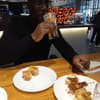Podcast
Questions and Answers
Which of the following is NOT a function of the immune system?
Which of the following is NOT a function of the immune system?
- Stopping infections and diseases
- Recognizing and destroying pathogens
- Developing immunological memory for future infections
- Facilitating nutrient absorption in the digestive system (correct)
The first line of defense of the immune system specifically targets and remembers pathogens that have previously infected the body.
The first line of defense of the immune system specifically targets and remembers pathogens that have previously infected the body.
False (B)
What is the role of phagocytes in the second line of defense?
What is the role of phagocytes in the second line of defense?
Phagocytes engulf and destroy pathogens.
During an infection, the body may raise its temperature, resulting in a __________, to slow down pathogens and help white blood cells function more effectively.
During an infection, the body may raise its temperature, resulting in a __________, to slow down pathogens and help white blood cells function more effectively.
Match the type of immune cell with its primary function:
Match the type of immune cell with its primary function:
Which of the following is an example of the body's first line of defense?
Which of the following is an example of the body's first line of defense?
T cells create antibodies to fight pathogens.
T cells create antibodies to fight pathogens.
How does inflammation help the body fight infection?
How does inflammation help the body fight infection?
Which of the following accurately describes the role of the small intestine?
Which of the following accurately describes the role of the small intestine?
The primary function of the respiratory system is to bring carbon dioxide into the body and remove oxygen.
The primary function of the respiratory system is to bring carbon dioxide into the body and remove oxygen.
In the respiratory system, gas exchange occurs in the tiny air sacs known as ________.
In the respiratory system, gas exchange occurs in the tiny air sacs known as ________.
What is the main function of the excretory system?
What is the main function of the excretory system?
What process moves food from the mouth to the stomach?
What process moves food from the mouth to the stomach?
Match each organ with its primary function in the excretory system:
Match each organ with its primary function in the excretory system:
Which organ produces enzymes to break down food during digestion?
Which organ produces enzymes to break down food during digestion?
The diaphragm contracts during exhalation to push air out of the lungs.
The diaphragm contracts during exhalation to push air out of the lungs.
Which of the following is an example of the body's first line of defense against pathogens?
Which of the following is an example of the body's first line of defense against pathogens?
A fever is part of the third line of defense, targeting specific pathogens with antibodies.
A fever is part of the third line of defense, targeting specific pathogens with antibodies.
What is the primary function of antibodies produced by B cells?
What is the primary function of antibodies produced by B cells?
__________ immunity is acquired when antibodies are received from an external source, like a mother's milk.
__________ immunity is acquired when antibodies are received from an external source, like a mother's milk.
Match the following components with the function they perform in immunity:
Match the following components with the function they perform in immunity:
Which of the following describes a primary concern associated with the overuse of antibiotics?
Which of the following describes a primary concern associated with the overuse of antibiotics?
Innate immunity is highly specific, targeting particular pathogens with specialized responses developed over time.
Innate immunity is highly specific, targeting particular pathogens with specialized responses developed over time.
Briefly explain the ethical dilemma surrounding mandatory vaccination.
Briefly explain the ethical dilemma surrounding mandatory vaccination.
The circulatory system transports oxygen and nutrients to cells and removes waste like __________.
The circulatory system transports oxygen and nutrients to cells and removes waste like __________.
Which type of blood vessel is responsible for carrying deoxygenated blood back to the heart?
Which type of blood vessel is responsible for carrying deoxygenated blood back to the heart?
Arteries have thin walls and wide interiors to facilitate blood flow under low pressure.
Arteries have thin walls and wide interiors to facilitate blood flow under low pressure.
What structural feature of capillaries facilitates the exchange of oxygen and nutrients with cells?
What structural feature of capillaries facilitates the exchange of oxygen and nutrients with cells?
The digestive system breaks down food into smaller molecules, which are then absorbed in the __________.
The digestive system breaks down food into smaller molecules, which are then absorbed in the __________.
In which organ does the breakdown of food begin?
In which organ does the breakdown of food begin?
The large intestine primarily functions to absorb nutrients from digested food.
The large intestine primarily functions to absorb nutrients from digested food.
Flashcards
Immune System
Immune System
The body's defense system against pathogens like bacteria and viruses.
Pathogens
Pathogens
Harmful diseases, such as bacteria, viruses, fungi, and parasites.
1st Line of Defense
1st Line of Defense
The body's initial protection against infections via barriers.
Barriers
Barriers
Signup and view all the flashcards
2nd Line of Defense
2nd Line of Defense
Signup and view all the flashcards
Inflammation
Inflammation
Signup and view all the flashcards
B Cells
B Cells
Signup and view all the flashcards
T Cells
T Cells
Signup and view all the flashcards
Mouth
Mouth
Signup and view all the flashcards
Esophagus
Esophagus
Signup and view all the flashcards
Stomach
Stomach
Signup and view all the flashcards
Small Intestine
Small Intestine
Signup and view all the flashcards
Large Intestine
Large Intestine
Signup and view all the flashcards
Lungs
Lungs
Signup and view all the flashcards
Kidneys
Kidneys
Signup and view all the flashcards
Excretory System
Excretory System
Signup and view all the flashcards
Pathogen Entry
Pathogen Entry
Signup and view all the flashcards
Antibodies
Antibodies
Signup and view all the flashcards
Active Immunity
Active Immunity
Signup and view all the flashcards
Passive Immunity
Passive Immunity
Signup and view all the flashcards
Vaccination
Vaccination
Signup and view all the flashcards
Antibiotics
Antibiotics
Signup and view all the flashcards
Vaccine Function
Vaccine Function
Signup and view all the flashcards
Innate Immunity
Innate Immunity
Signup and view all the flashcards
Adaptive Immunity
Adaptive Immunity
Signup and view all the flashcards
Circulatory System
Circulatory System
Signup and view all the flashcards
Heart Function
Heart Function
Signup and view all the flashcards
Digestive System
Digestive System
Signup and view all the flashcards
Study Notes
Immune System
- Immune System Function: Protects the body from pathogens (bacteria, viruses, fungi, parasites) by recognizing, destroying, and preventing infections. It has a memory to more effectively fight future infections.
Three Lines of Defense
-
1st Line of Defense (Non-Specific Barriers): This line prevents pathogens from entering the body.
- Skin: Acts as a physical barrier.
- Mucous Membranes: Trap microbes in the nose, mouth, lungs, and digestive system.
- Stomach Acid: Kills bacteria ingested with food or drinks.
- Tears and Saliva: Contain enzymes that destroy bacteria.
- Nasal Hair and Mucus: Trap and filter dust, dirt, and germs.
- Coughing and Sneezing: Expel pathogens from the body.
-
2nd Line of Defense (Non-Specific Immune Response): Activated when pathogens penetrate the first line.
- Inflammation: Redness, swelling, and warmth at the infection site; increased blood flow brings white blood cells.
- Fever: Elevated body temperature slows pathogen growth.
- Phagocytes (White Blood Cells): Engulf and destroy pathogens.
-
3rd Line of Defense (Specific Immune Response): Targets specific pathogens with specialized white blood cells, lymphocytes.
- B Cells (B Lymphocytes): Create antibodies to fight pathogens; have memory for future infections.
- T Cells (T Lymphocytes): Destroy infected cells and help B cells; recognize and kill viruses.
How the Immune System Works (Overall)
- Pathogens enter the body (cut, inhalation, food).
- The first line of defense tries to stop it.
- If successful, the second and third lines are triggered.
- Inflammation and fever occur.
- Phagocytes eliminate pathogens.
- B cells produce antibodies.
- T cells attack infected cells.
- If the infection continues, the body takes time to fight it off.
- Memory cells remain in the body, allowing a faster response to future infections.
B Cells and Antibodies
- B Cells: White blood cells producing antibodies.
- Antibodies: Y-shaped proteins that bind to pathogens, weaken them, and signal phagocytes to destroy them.
Active vs. Passive Immunity
- Active Immunity: The body produces its own antibodies after exposure to a pathogen (infection or vaccination).
- Passive Immunity: Antibodies are received from another source (e.g., mother's milk, antibody injection).
Vaccination
- Vaccine: A weakened or inactive version of a pathogen that trains the immune system to fight it without causing severe illness.
- How a Vaccine Works: Injection of harmless pathogen part; immune system responds and creates antibodies; memory cells are stored for future pathogen encounters.
- Example: The COVID-19 vaccine helps the body recognize and fight the virus without a severe illness.
Antibiotics vs. Vaccines
- Antibiotics: Kill bacteria. Used for bacterial infections; can be detrimental with misuse.
- Vaccines: Prevent infections. Used for viral infections; more effective in preventing infection.
Antibiotic Resistance
- Overuse of antibiotics leads to bacteria becoming resistant.
- Resistant bacteria (superbugs) are harder to treat.
- Use antibiotics only when necessary.
Innate vs. Adaptive Immunity
- Innate Immunity: Fast, non-specific response; no memory. Uses phagocytes, other cells.
- Adaptive Immunity: Slow, specific response; creates memory. Uses B and T cells.
Ethical Issues with Vaccination
- Mandatory vaccination debates involve public health benefits vs. individual choice concerns.
Other systems (brief overview) Circulatory, Digestive, Respiratory & Excretory System
- Circulatory system (cardiovascular): Transports blood and oxygen throughout the body.
- Digestive system: Breaks down food into nutrients.
- Respiration system: Brings in and expels oxygen and carbon dioxide for the body.
- Excretory system: Removes waste products from the body.
Studying That Suits You
Use AI to generate personalized quizzes and flashcards to suit your learning preferences.
Description
The immune system protects the body from pathogens through multiple lines of defense. The first line includes physical barriers like skin and mucous membranes. The second line involves non-specific responses such as inflammation to fight infections.





